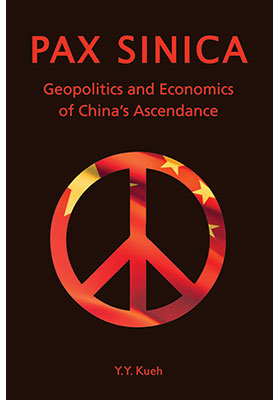Pax Sinica
Geopolitics and Economics of China’s Ascendance
(走向中華「帝國」的昇平盛世:地緣政治經濟學視角)
ISBN : 978-988-8083-82-4
October 2012
460 pages, 6″ x 9″, 16 b&w illus.; 80 tables
- HK$295.00
Ebooks
The book confronts the popular conjecture of a Pax Sinica emerging to replace Pax Americana in the wake of global financial crisis. It argues that by virtue of its overwhelming economic, technological and military clout, US hegemony will continue to prevail, though increasingly less coherently, as China’s ascendance as a global power accelerates. The argument is underpinned with analysis of different junctures in China’s trajectory towards the status of economic giant, from the tacit creation of the “Greater China” growth triangle and ordeal of the Asian Financial Crisis, through the breakthrough with China’s membership in the WTO and the subsequent large-scale realignment of productive forces in the Asia Pacific region. A chronological approach is combined with topical analysis, focusing in particular on the interplay between economic imperatives and geopolitical dynamics.
Taken together, the book provides a highly refreshing and coherent perspective for looking at China arising as a dominant Asia-Pacific power with significant global implications. As an interdisciplinary study it will appeal to scholars and academics, as well as businessmen and government policy-makers interested in Asian and global affairs; and especially to students of economics, politics, international business and globalization studies.
“This is a superb rendition of the story of China’s post-Mao metamorphosis into an economic powerhouse that has become the engine of regional, and even global, growth. It packs lucid analysis and interpretation in a treatise that demystifies the success of the Dengist ‘reform and open up’ (the Great Leap Outward) coup and its enduring legacy. Succinctly the study illustrates what may be considered the three pillars of the Chinese dynamo: the Greater China complex (i.e., partnership with Hong Kong, Taiwan, and Macau); integration with WTO, APEC, ASEAN 10, and other FTAs; and the unique feat of welding an increasingly marketized economy onto the country’s socialist system. Despite its title, Pax Sinica does not anticipate, as most alarmist predictions do, that the Chinese economic superpower is going to shatter and replace Pax Americana anytime soon. Other than the regional limit of China’s influence (partly by preference) and the vast gap in its technological and military might behind the United States (partly by choice), a cultural variable (the post–1995 adherence to Confucianism-cum-Buddhism) may explain China’s willingness to bandwagon to, rather than balancing against, the existing hegemonic power. It makes theory and the high drama of the interplay of geopolitics and geoeconomics easy for the layperson to comprehend. A must read for specialists, government leaders, and the public as well.” —James C. Hsiung, Professor of Politics and International Law, New York University
“This volume contains highly refreshing and coherent articles about China’s rise at different junctures since opening up to the west. They blend insightful economic analysis with institutional and geopolitical perspectives.” —Cheng Hsiao, Professor of Economics, University of Southern California, Los Angeles
“Unlike books filled with esoteric econometric modelling, Pax Sinica applies standard statistical methods to reveal composition and trends of output, commodity trade, and investment flows. Analytical nuance notwithstanding, the explanation and discussion presented, coupled with the geopolitical perspective, are all readily comprehensible and highly readable.” —Yue Ma, Chair Professor of Finance, City University of Hong Kong
“Much has been published on the spectacular rise of China to be the world’s second largest economy and No. 1 exporter. But there are few works on China’s increased ties with the APEC countries which constitute a very important dimension of global economic development and help consolidate the foundation for a highly integrated Asia-Pacific production network and the emergence of a Pacific century. This book fills a crucial gap in the current literature.” —Joseph C. H. Chai, former Associate Professor of Economics, University of Queensland, Australia
“Pax Sinica is extensively footnoted and filled with detailed charts containing a vast wealth of economic data, and is useful as a macroeconomic reference index by itself. In conclusion, I find the author’s thesis compelling and largely correct.” —Nicholas MacDonald, iTV-Asia.com
“Y.Y. Kueh’s study offers a much needed and an extremely erudite analysis of China’s emerging international agency. Not surprisingly, his book will be welcomed by students, scholars, and policy-makers alike.” —Emilian Kavalski, Institute for Social Justice, ACU-Sydney



